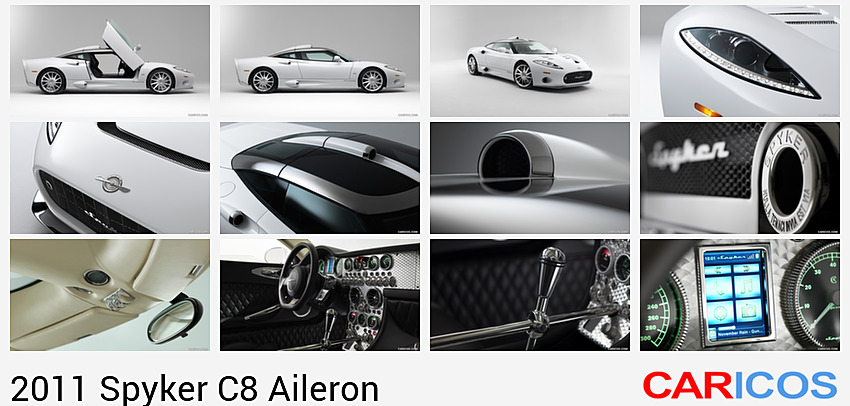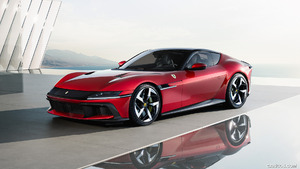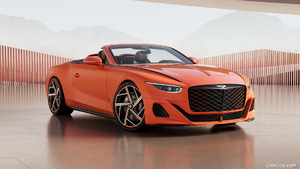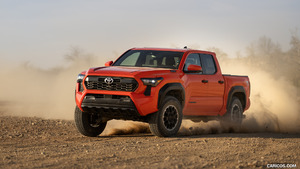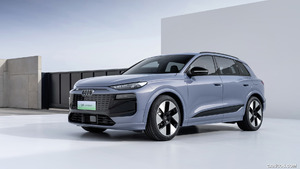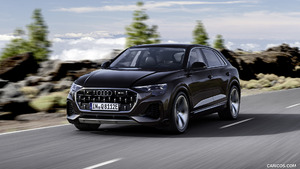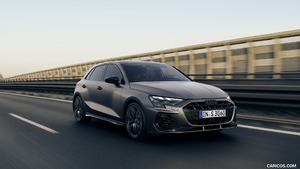The Spyker C8 Aileron marks an important milestone in Spyker Cars’ evolution. The car was initially unveiled at the 2009 Salon International de l’Automobile in Geneva, and the Spyker C8 Aileron coupe took pride of place at the 2010 show just before entering production.
Inspired by the company’s aviation heritage, Spyker’s second-generation sports car features cues from second-generation aircraft propulsion, highlighting the turbine blade, rather than the propeller which adorned many elements of Spyker’s first generation cars.
With sleek aerodynamics, a long GT wheelbase, luxurious and spacious cabin and worldclass ZF six-speed automatic transmission, the new C8 Aileron broadens the appeal of the Spyker brand while maintaining the marque’s exclusivity.
Second-generation design exploits advanced computer aids
The design of the hand-crafted Spyker C8 Aileron represents Spyker’s signature architecture, which is heavily inspired by the company’s aviation heritage. In the first-generation cars, the propeller design was consistently applied to many elements of the vehicles. With the design of the Spyker C8 Aileron, the emphasis shifted from propeller propulsion to turbine propulsion. As a result, detailing on the car, such as the bright polished air inlets, are turbine-engine-shaped air scoops.
The smooth, elegant and powerful lines of the distinctive design are the result of a virtual aero computer programme . The Aileron’s beautiful lines are complimented by the minimal ‘shut’ lines and an uncompromised design made possible by the use of superformed alloy body panels. The superforming process heats aluminium to 500 degrees Celsius and then vacuum forms the metal onto an inverted mould over a 30 minute period. Additionally, there are no breaks along the entire path of the door ring seals, guaranteeing maximum integrity against the elements.
At the front, the style of the C8 Aileron’s headlights is particularly eye-catching as they flow seamlessly from the body design. This characteristic styling can be defined as a part of the next generation Spyker identity first seen on the Spyker C12 Laturbie prototype and subsequently in the Spyker D8 Peking-to-Paris protoype.
Latest-generation LEDs are used for the front and rear turn indicators and the sidelights within the sharply-styled headlight units.
Styling and functionality are harmonised in several characteristics of the car. The cockpit canopy, for example, is extended rearwards to optimise the aerodynamic performance of the car. Most of the shark-like gills of earlier models have been abandoned, which results in a cleaner, smoother appearance. The front end is characterised by a large grille that has spectacular visual impact and also allows maximum flow of cooling air. The rear diffuser is crucial to the car’s stability at speed, with a spoiler placed under the diffuser, providing additional downforce to boost the ground effect forces produced by the under-car airflow and the diffuser.
Sometimes practicality must take precedent even with a design-led marque such as Spyker. So, for the C8 Aileron the split side windows with the characteristic metal frame of the first generation models are replaced by single-pane side windows that are fully retractable, improving visibility and comfort. The exterior mirrors, which are finished in body colour as standard, are mounted on two turbine fan blades.
V8 powertrain and automatic drivetrain
The Spyker C8 Aileron’s performance is visceral, vibrant and alive. Power comes from a naturally aspirated Audi 4.2-litre V8 petrol engine. This powerunit features a 90 degree angle block, 40 valves (5 valves-per-cylinder, 3 intake and 2 exhaust), and variable valve timing. Highly responsive, the V8 generates 400 ps at 6,800 rpm and an immense wave of torque (480 Nm at just 3,500 rpm), to ensure thrilling drivability.
Strong torque, high power, sleek aerodynamics, modest car weight and an excellent powerto-weight ratio all result in sensational acceleration: 0-to-100 kph in 4.5 seconds and a top speed of 300 kph.
As standard, the engine is fitted with a long-life stainless steel exhaust system tuned to put the driver ‘truly in touch with their senses’ – according the company CEO Victor Muller. Also standard in Europe is an exhaust system with ‘Whisper’ mode (optional outside Europe). This system uses noise-dampening reed valves to create a quieter drive below 3,500 rpm. The valves naturally open as engine speed rises above this figure, and can be opened electronically below this speed by the driver if desired.
Marking a ‘first’ for Spyker, the C8 Aileron’s engine is mated to an automatic transmission that provides seamless, yet instant, progression through the gears. The highly regarded sixspeed ZF gearbox features a regular torque converter and offers drivers a choice of fully automatic or clutch-less sequential manual gear shifting using the standard paddle shifts behind the steering wheel.
The transmission selection operation retains Spyker’s trademark exposed gear change mechanism that provides a sense of occasion and proves that aesthetics and function go hand-in-hand.
The aluminium paddle shift controls are substantive and easy to reach. They do not rotate with the steering wheel, allowing the driver to easily identify the up-shift and down-shift paddles, regardless of the steering wheel’s angle.
In line with Spyker’s philosophy of delivering an undiluted sportscar driving experience, the drivetrain is not equipped with a limited-slip differential or any other mechanical or electronic aids.
Ultra-stiff, all-aluminium space frame chassis
Spyker’s engineering team conceived an all-new all-aluminium space frame structure for the C8 Aileron with the objective of maximised torsional and flexural rigidity. It provides an excellent foundation for the tailor-engineered suspension system designed and engineered by Lotus to Spyker’s brief.
Spyker put tremendous effort into optimising the space frame’s performance and efficiency, for example adopting one-piece side sills that make an important contribution to chassis stiffness. The utilization of modern finite element analysis and numerical optimization methods allowed Spyker’s engineers to create a new chassis for the C8 Aileron, which boasts an exceptional torsional stiffness of 29,500 Nm/degree.
Rigid-node and load-path technology was employed in order to ensure that the minimum amount of aluminium is used to achieve this performance, thus reducing the overall weight of the vehicle. The production chassis weighs just 230 kg.
Dynamic stiffness characteristics of the structure are carefully tuned in order to minimise unwanted cabin noises and vibrations, which may otherwise detract from the superlative driving experience. These technologies and measures allowed Spyker to arrive at the most efficient chassis in its history at the time it was conceived.
Suspension and running gear
The C8 Aileron is fitted with a fully independent double-wishbone suspension system (front and rear) developed by Lotus. This multi-adjustable suspension system incorporates a new kinematic layout of the front and rear suspension systems.
Stabiliser bars are fitted front and rear, together with Bilstein mono-tube dampers and Eibach coil over damper steel springs integrating the spring with the near-vertical shock absorber. The system’s constant spring rates are 132 NM/mm (front) and 160 NM/mm (rear). An optional KW hydraulic ride height elevation system is available to ensure safe passage over speed humps and steep ramp angles. It raises the ride height by 40 mm.
The suspension components are made of forged aluminium wherever possible to keep the vehicle’s unsprung weight to a minimum. This goal is also supported by the use of special lightweight alloy wheels, which weigh just 36% of an equivalent steel wheel, and alloy brake callipers.
As standard, the Aileron is equipped with unique 19-inch alloy wheels. High-impact 10-blade 19-inch directional Rotorblade™ wheels are available as an option. These optional wheels are inspired by the turbine blades of a jet engine, echoing the new styling direction for Spyker, while acknowledging the company’s aviation heritage. The C8 Aileron’s generously proportioned Michelin tyres – 235/35 ZR19 (front) and 295/30 ZR19 (rear) – provide exceptional grip and progressive handling.
A stiff chassis, well balanced weight distribution (45/55% front/rear), and rear wheel drive, ensure that the C8 Aileron posses excellent steering ‘feel’. The Servotronic speed-sensitive rack and pinion system has hydraulic power assistance and requires 3.0 turns of the steering wheel lock-to-lock.
As appropriate for a supercar with the performance potential of the C8 Aileron, the braking system is immensely powerful. Designed and supplied by AP Racing, a Spyker partner from day one, the system features ventilated and cross-drilled steel discs front and rear for rapid dispersion of heat. High performance Ferodo DS2500 brake pads ensure good brake ‘feel’, excellent initial bite and fade characteristics, plus low noise and good durability.
Black brake calipers with the Spyker script in silver are fitted as standard. Colour-coded calipers with Spyker script in silver can be ordered as an option.
Hand-crafted cabin with comfort and space aplenty
The Spyker C8 Aileron has been designed to offer ample interior space for 98th percentile occupants, an unequivocally comfortable experience for driver and passenger, and exceptional, but truly unique, ergonomics. As standard, each C8 Aileron is fitted with driver and passenger front airbags.
The interior, with its signature Spyker attention to detail, is made of the highest quality leather. The leather interior is available in 14 standard colours, but a wide variety of other colours – to suit individual customer preferences – can be ordered as an option. Spyker’s trademark diamond stitched quilted interior trim finish is available as an option – as are Alcantara® and a duo-tone cabin.
The Aileron’s interior amplifies further the signature Spyker aviation theme. The brushed aluminium dashboard is an all-new design aligned paving the way for the next-generation Spyker identity and also to maximise ergonomics, solid tactility and straightforward functionality. A turned aluminium dashboard, as seen on planes in the 1920s and 1930s, and Chronoswiss dials and switches are available as an option. The air vents are designed in turbine style. Even the Spyker characteristic floor-mounted pedal box is exquisite in its detailing.
A LCD display is integrated between the speedometer and the odometer to show the current selection and status of the in-car entertainment options offered by the standard Kharma sound system accommodated in the centre console.
Spyker C8 Aileron Spyder concept
The Spyder concept was first unveiled at the 59th Pebble Beach Concours d’Elegance in California in August 2009, and made its European debut in Geneva in 2010.
The Spyder concept sports a high-quality, semi-automatic canvas soft-top with integrated glass rear windscreen. The roof operation is electric/hydraulic, secured by one central latch operated manually. Once folded, the soft-top is totally enclosed within the body of the car, ensuring a clean, undisturbed profile.
The roof retracts under an aluminium tonneau, with two buttresses upholstered in quilted leather matching the car’s interior and featuring the company’s motto ‘Nulla Tenaci Invia Est Via’: for the tenacious, no road is impassable.
The Spyder concept features a luggage rack, CNC-machined from solid billets of aluminium, mounted immediately behind the roll hoops, on which its wing-shaped aluminium case can be strapped. The case is trimmed in the same quilted leather as the interior and buttresses.
Prices
(All prices quoted are exclusive of local taxes, fees, and delivery charges unless otherwise stated.)
- UK £ 194,000 on-the-road
- Germany € 236,215 on-the-road
- Europe € 198,500
- Russia € 170,000
- Middle East US$ 244,990

